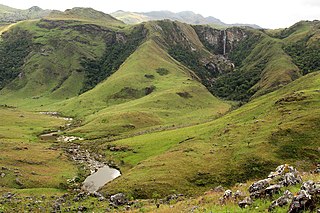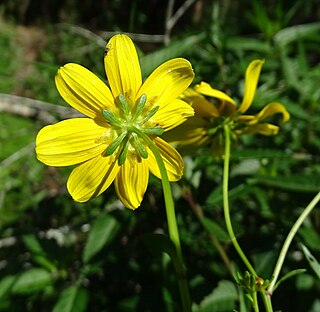
Marrubium vulgare is a flowering plant in the mint family (Lamiaceae), native to Europe, northern Africa, and southwestern and central Asia. Specifically, it emerged in the region between the Mediterranean Sea and Central Asia and now inhabits all continents. It is also widely naturalized in many places, including most of North and South America.

Sorrel, also called common sorrel or garden sorrel, is a perennial herbaceous plant in the family Polygonaceae. Other names for sorrel include spinach dock and narrow-leaved dock.

A grassland is an area where the vegetation is dominated by grasses (Poaceae). However, sedge (Cyperaceae) and rush (Juncaceae) can also be found along with variable proportions of legumes, such as clover, and other herbs. Grasslands occur naturally on all continents except Antarctica and are found in most ecoregions of the Earth. Furthermore, grasslands are one of the largest biomes on Earth and dominate the landscape worldwide. There are different types of grasslands: natural grasslands, semi-natural grasslands, and agricultural grasslands. They cover 31–69% of the Earth's land area.

Herbaceous plants are vascular plants that have no persistent woody stems above ground. This broad category of plants includes many perennials, and nearly all annuals and biennials.

Calcareous grassland is an ecosystem associated with thin basic soil, such as that on chalk and limestone downland. Plants on calcareous grassland are typically short and hardy, and include grasses and herbs such as clover. Calcareous grassland is an important habitat for insects, particularly butterflies and ants, and is kept at a plagioclimax by grazing animals, usually sheep and sometimes cattle. Rabbits used to play a part but due to the onset of myxomatosis their numbers decreased so dramatically that they no longer have much of a grazing effect.

The Madagascar ericoid thickets is a montane shrubland ecoregion, found at higher altitudes on Madagascar's four major mountains.

Kibale National Park is a national park in western Uganda, protecting moist evergreen rainforest. It is 766 square kilometres (296 sq mi) in size and ranges between 1,100 metres (3,600 ft) and 1,600 metres (5,200 ft) in elevation. Despite encompassing primarily moist evergreen forest, it contains a diverse array of landscapes. Kibale is one of the last remaining expanses to contain both lowland and montane forests. In eastern Africa, it sustains the last significant expanse of pre-montane forest.

Entada rheedii, commonly known as African dream herb or snuff box sea bean, and as the cacoon vine in Jamaica, is a large woody liana or climber of the Mimosa clade Mimosoideae. The vine can grow as long as 120 m (390 ft). Their seeds have a thick and durable seed coat which allows them to survive lengthy periods of immersion in seawater.

Alepidea peduncularis is an edible perennial herb native to the montane grasslands of East and South Africa.

Denham's bustard, Stanley bustard or Stanley's bustard is a large bird in the bustard family. It breeds in much of Sub-Saharan Africa. It is a species of open ground, including agricultural land, grassland, flood-plains and burnt fynbos. It is resident, but some inland populations move to lower altitudes in winter. The common names for this species refer to the English explorer, Major Dixon Denham, and the English naturalist Edward Smith-Stanley, 13th Earl of Derby.

Rhynchosia, also known as snoutbean, is a genus of plants in the family Fabaceae. It includes 260 species of herbs, vines, and subshrubs native to tropical, subtropical, and warm temperate regions around the world, ranging from the southern United States to northern Argentina in the Americas, and through Africa, the Arabian Peninsula, southern Asia from Iran to Korea and Japan, New Guinea, and Australia. Typical habitats include seasonally-dry forest, forest margins, woodland, thicket, wooded grassland, shrubland, and grassland, often in open rocky areas, disturbed areas, or along streams. Many species are pyrophytes. There are several different complexes within the genus, including the Senna complex.
Psophocarpus is a genus of flowering plants in the legume family, Fabaceae. It includes nine species of climbing herbs or subshrubs native to tropical Africa. Typical habitats include seasonally-dry tropical forest and forest margins, moist wooded grassland and grassland, thicket, swamp, and secondary vegetation. It belongs to subfamily Faboideae.

The Ethiopian montane moorlands is a montane grasslands and shrublands ecoregion in Ethiopia. It lies above 3,000 meters elevation in the Ethiopian Highlands, the largest Afroalpine region in Africa. The montane moorlands lie above the tree line, and consist of grassland and moorland with abundant herbs and shrubs adapted to the high elevation conditions.

Ilex mitis is a tall, dense, evergreen tree that is indigenous to Sub-Saharan Africa and Madagascar. It makes an excellent fast-growing hedge for gardens - growing tall, straight and dense.

Southern Afrotemperate Forest is a kind of tall, shady, multilayered indigenous South African forest. This is the main forest-type in the south-western part of South Africa, naturally extending from the Cape Peninsula in the west, as far as Port Elizabeth in the east. In this range, it usually occurs in small forest pockets, surrounded by fynbos vegetation.

Wajira is a small genus of flowering plants in the legume family, Fabaceae. It includes five species of climbing herbs or subshrubs native to tropical Africa, the Indian subcontinent, and Thailand. Four species are native to the Somali-Masai region of northeastern tropical Africa. Wajira grahamiana is more widespread in Africa and ranges to the Indian subcontinent and Indochina. Typical habitats are seasonally-dry tropical forest, woodland, bushland, and grassland. It belongs to the subfamily Faboideae. Species in this genus were formerly considered to belong to the genus Vigna. A key for the genus has been published.

The Chimanimani Mountains are a mountain range on the border of Zimbabwe and Mozambique. The mountains are in the southern portion of the Eastern Highlands, or Manica Highlands, a belt of highlands that extend north and south along the international border, between the Zambezi and Save rivers.

Bidens mitis, the smallfruit beggarticks, is a North American species of flowering plant in the family Asteraceae. It is native to the eastern, southeastern, and south-central parts of the United States, from eastern Texas to southern New Jersey.
The Zambezian region is a large biogeographical region in Africa. The Zambezian region includes woodlands, savannas, grasslands, and thickets, extending from east to west in a broad belt across the continent. The Zambezian region lies south of the rainforests of the Guineo-Congolian region. The Zambezian region is bounded by deserts and xeric shrublands on the southwest, the Highveld grasslands of South Africa to the south, and the subtropical Maputaland forests on the southeast.
Zornia glochidiata is a leguminous herb of the Fabaceae family, it is widely distributed in the Sahel regions of West Africa. It is reputed to be an important forage plant in the region.
















